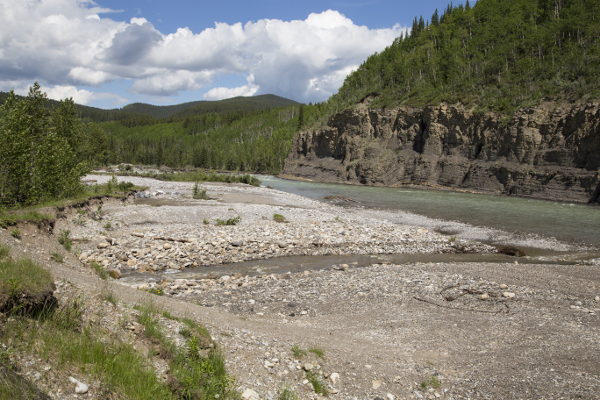Today’s post is courtesy of Adam Driedzic, Staff Counsel at the Environmental Law Centre, and first appeared on the ELC blog. If you would like to read more about environmental legislation, public policy or regulation, visit the Environmental Law Centre website or blog.
 |
| “ERWP stop 2 Elbow dam site” by Mike BRBC is shared with permission. |
This question was raised at the Oldman Watershed Council Annual General Meeting. The “dry dam” proposed for the Elbow River is no small deal. It could be the same type of towering concrete wall that contains permanent reservoirs except that it would usually sit empty. If it is allowed to remain full for long enough to reduce flooding downstream then it might kill the underlying vegetation. The photo of a mountain valley turned into a dustbowl by a similar project elsewhere was one of the more striking images at the meeting.
To figure out whether an environmental impact assessment (EIA) is required you need to find out the height of the dam and how much water it would hold. A provincial assessment is required for a dam greater than 15 metres in height when measured to the top of the dam “from the natural bed of the watercourse at the downstream toe of the dam.” If the dam isn’t across a watercourse then the measurement is from “the lowest elevation at the outside of the dam.” A provincial assessment is also required for a water reservoir with a capacity over 30 million cubic metres no matter how high the dam is.
The other project being considered as I understand it is to divert the Highwood River around the town of High River. In this case a provincial assessment would be required for a “water diversion structure and canals with a capacity greater than 15 cubic metres per second.” Even if the project doesn’t meet these technical requirements the Minister of Alberta Environment and Sustainable Resource Development could still order an EIA but there would be no way to force one.
If there is a provincial assessment it will trigger an NRCB review of a “water management project.” No person can start such a project without an NRCB review and it shouldn’t matter that the government is the project proponent as the NRCB Act is binding on the Crown. A “water management project” is defined by the NRCB Act as a project for which an environmental impact assessment is required so getting the environmental assessment is the key to getting an NRCB review. As part of the review the NRCB can make investigations or inquiries, prepare studies or reports, or hold hearings. This review could get underway with low key studies or reports. The NRCB only has to hold a public hearing if someone is directly affected. If a hearing is triggered then further persons can apply to participate. Regardless of the review format the NRCB must provide 30 day notice of any necessary proceedings. This notice would likely be in local newspapers, prominent community locations or provided to persons in the area who may be directly affected.
The chance of a federal environmental assessment is lower since the 2012 reforms. For a dam, a federal assessment is required for: “the construction, operation, decommissioning and abandonment of a new dam or dyke that would result in the creation of a reservoir with a surface area that would exceed the annual mean surface area of a natural water body by 1 500 ha or more.” For a diversion project, a federal assessment is required for: “The construction, operation, decommissioning and abandonment of a new structure for the diversion of 10 000 000 m3/year or more of water from a natural water body into another natural water body.” Federal assessments are now only required for listed projects. They will no longer be triggered based on the need for fisheries act permits. Likewise the Elbow and Highwood Rivers are no longer protected under the Navigable Waters Protection Act as reforms reduced protection to listed water bodies. If a Federal assessment is required then the federal government can substitute an equivalent provincial assessment to meet its own requirement. There is no more need for joint provincial-federal panel reviews as there was before 2012.
Adam Driedzic works as Staff Counsel a the Environmental Law Centre. Adam’s major project work is on land use planning, public participation rights and access to information. He also contributes to ongoing ELC initiatives on conservation tools and environmental assessment.
